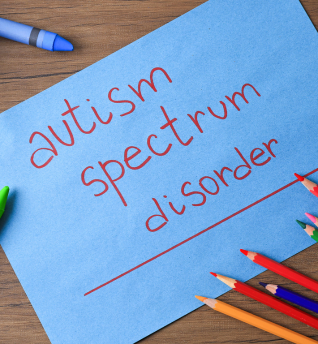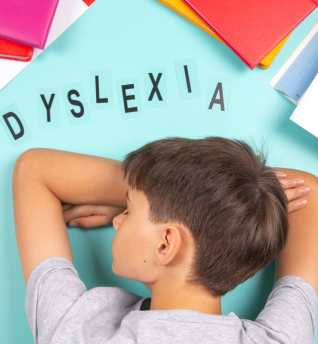Symptom Checker
ASD
-
Autism Spectrum Disorders refer to a range of conditions characterised by challenges with social interaction, repetitive behaviors, and speech and nonverbal communication, and usually come with unique sets of strengths and weaknesses. There is no one Autism, but many types, caused by different combinations of genetic and environmental influences. The term “spectrum” reflects the wide variation in challenges and strengths each person with Autism possesses.
-
Autism’s most obvious signs tend to appear between 2 and 3 years of age. In some cases, it can be diagnosed as early as 18 months. With early intervention, children with Autism can often make meaningful improvement in their daily living and social life.
What are the early signs of Autism?
-
• By 6 months, no social smiles or other warm, joyful expressions directed at people
• By 6 months, limited or no eye contact
• By 9 months, no sharing of vocal sounds, smiles or other nonverbal communication
• By 12 months, no babbling
• By 12 months, no use of gestures to communicate (e.g. pointing, reaching, waving, etc.)
• By 12 months, no response to name when called
• By 16 months, no words
• By 24 months, no meaningful, two-word phrases
• Loss of previously acquired speech, babbling or social skills
-
• In play group, avoidance of eye contact and preference to be alone
• Struggles with understanding other people’s feelings
• Remaining nonverbal or delayed language development
• Repetition of words or phrases over and over (echolalia)
• Getting upset by minor changes in routine or surroundings
• Highly restricted interests
• Performing repetitive behaviours such as flapping, rocking or spinning
• Unusual and often intense reaction to sounds, smells, tastes, textures, lights, and/or colors
-
Currently, there are no valid and reliable brain or genetic tests that can accurately diagnose Autism. Diagnosing ASD takes two steps: a developmental screening, and a comprehensive diagnostic evaluation conducted by child neuropsychologists and developmental paediatricians.
-
Currently, there is no known cure for this condition. Listed below are evidence-based early interventions that have proven effective in improving the lives of children with Autism.
-
Applied behavior analysis and ABA therapy focus on developing positive behaviors and discouraging negative behaviors in order to enhance a variety of skills.
-
Floortime focuses on emotional and relational development (e.g. feelings, relationships with caregivers). It also focuses on how the child deals with sights, sounds, and smells.
-
TEAACH uses visual cues to teach skills. For example, picture cards can help teach a child how to get dressed by breaking information down into small steps.
-
Occupational therapy teaches skills that help the person live as independently as possible. Skills might include dressing, eating, bathing, and relating to people.
-
Sensory integration therapy helps the person deal with sensory information, like sights, sounds, and smells. Sensory integration therapy can help a child who is bothered by certain sounds or does not like to be touched.
-
Speech therapy helps to improve a person’s communication skills. Some people are able to learn verbal communication skills. For others, using gestures or picture boards is more realistic.
-
PECS uses picture symbols to teach communication skills. The person is taught to use picture symbols to ask and answer questions, and have a conversation.
-
Social skills curriculum teaches children on the spectrum how their behaviors can have positive or negative impact on others’ thoughts, feelings and reactions to them.
-
Although some dietary treatments are available, many do not have the scientific support needed for widespread recommendation. The results are often anecdotal in nature.
-
To relieve the symptoms of ASD, some parents and health care professionals use treatments that are outside of what is typically recommended by paediatricians. These types of treatments are known as complementary and alternative treatments (CAM). They include special diets, chelation (a treatment to remove heavy metals like lead from the body), biologicals (e.g. secretin), or body-based systems (like deep pressure).
These types of treatments are highly controversial. Current research shows that as many as one third of parents of children with ASD may have tried complementary or alternative medicine treatments, and up to 10% may be using a potentially dangerous treatment. Before starting such a treatment, investigate it carefully, and talk to your child’s doctor.
To learn more about CAM therapies, go to the National Center for Complementary and Alternative Medicine Get the Facts webpage.
Reference: Autism Speaks
ADHD
-
If your child can not sit still, never seems to listen and does not follow instructions, no matter how clearly you present them, Attention Deficit Hyperactivity Disorder (formerly known as Attention Deficit Disorder) may be the cause. Some children with ADHD will make inappropriate comments at inappropriate times. Children with ADHD may be labeled as troublemakers, lazy, or undisciplined at school.
Not all children with ADHD are overactive, but almost all of them have trouble concentrating on activities that are boring or repetitive to them and when there is a lot going on around them. Some children with ADHD are impulsive and have trouble waiting their turn. They can be easily excited and over-reactive emotionally.
-
ADHD should be diagnosed with stringent assessment of the child’s history, including family, health, and developmental histories, intelligence, attention and impulse control, and executive functioning skills with input from parents and teachers, use of ADHD symptom checklist, and direct testing of the child.
-
To help a child with ADHD, parents and teachers need to understand ADHD and well educated about behavior techniques and support principles. The child’s attention can be enhanced through exercise and nutrition. Some children with ADHD may benefit from medication prescribed by a paediatrician or psychiatrist.
Reference: Helpguide
Dyslexia
-
Dyslexia is a learning disability that alters the way the brain processes written material and is typically characterised by difficulties with word recognition, spelling, and decoding. Children and adults with Dyslexia have problems with word reading, spelling, reading fluency, and reading comprehension. It is a neurological and often a genetic condition. It is not the result of poor teaching, instruction or upbringing. Dyslexia is not linked to intelligence.
-
• Despite having normal intelligence and receiving proper teaching and parental support, the child has difficulty learning to read.
• The child learns to crawl, walk, talk, tie shoelaces, and perform other self-help skills later than the majority of other kids.
• Apart from being slow to learn to speak, the child commonly mispronounces words, finds rhyming extremely challenging, and does not appear to distinguish between different word sounds.
• At school, the child takes much longer than other children to learn the letters of the alphabet and how they are pronounced. There may also be problems remembering the days of the week, months of the year, colours, and arithmetic tables.
• The child may be poorly coordinated and have frequent falls and accidents; catching a ball may be difficult.
• The child commonly gets "left" and "right" mixed up.
• Numbers and letters may be reversed without realising it.
• The child might not follow a pattern of progression seen in other children.
• The child may learn how to spell a word today and completely forget the next day.
• The child may be able to process the beginning sounds but not the other ones in words.
• The child may find it difficult to concentrate on repetitive mental tasks
• Some children with Dyslexia have recurrent ear infections that make it difficult for them to process speech sounds.
• When a child with Dyslexia expresses a sequence of ideas, it may seem illogical.
-
Researchers and scientists have not found the exact causes of dyslexia, but some evidence points to the possibility that the condition is inherited, as dyslexia often runs in families. A team of researchers discovered that variations in a gene, known as DCDC2, are associated with problems in reading performance.
-
A psychoeducational assessment can determine if a child has dyslexia. The assessment should cover the following areas:
• Background information including family history and early development
• Intelligence
• Oral language skills
• Word recognition
• Decoding: the ability to read new words by using letter-sound knowledge
• Phonological processing: the ability to perceive, hold and manipulate speech sounds in the mind
• Automaticity / fluency skills
• Reading comprehension
• Vocabulary knowledge
• Attention capacity
-
Although currently there is no “cure” for Dyslexia, there are a range of specialists and specific, targeted interventions such as the Orton-Gillingham approach that can help children and adults improve their reading and writing skills. The earlier the child is diagnosed and receives support, the more likely he or she will achieve long-term improvement.
Reference: Ascentis Awarding Organisation



